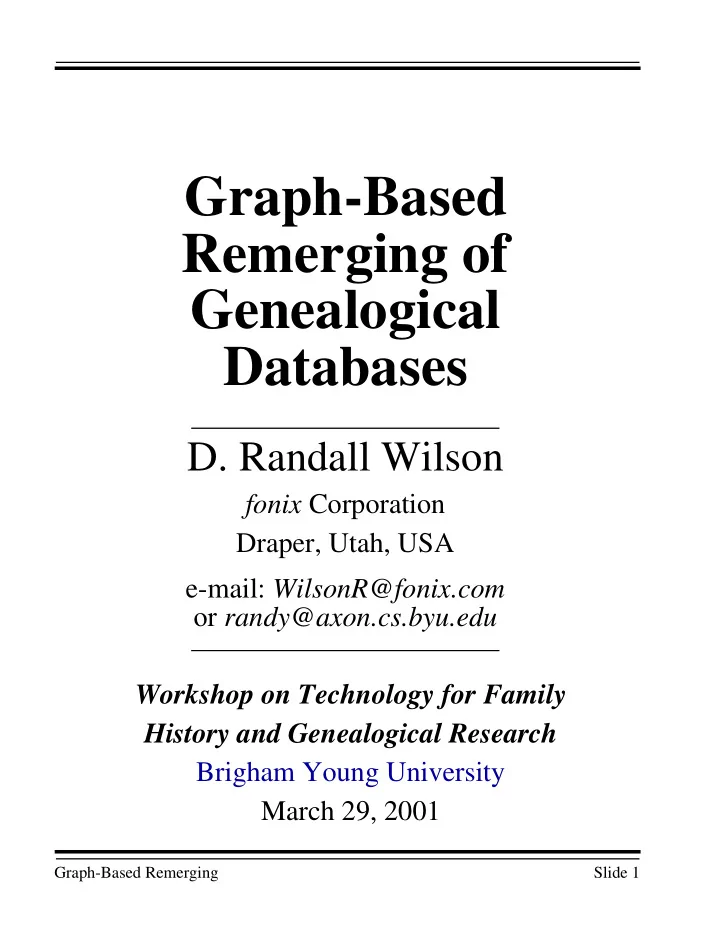

Graph-Based Remerging of Genealogical Databases D. Randall Wilson fonix Corporation Draper, Utah, USA e-mail: WilsonR@fonix.com or randy@axon.cs.byu.edu Workshop on Technology for Family History and Genealogical Research Brigham Young University March 29, 2001 Graph-Based Remerging Slide 1
“Remerging” Problem Original Database Share a copy Both make independent updates.... Now what?? Graph-Based Remerging Slide 2
Common Approaches • Give up • One person does everything, and everyone else is uninvolved; or • Everyone duplicates work for themselves. • Visual Inspection , and hand-typing • Unix “diff” command , and hand-typing • Match/Merge function • Import second database into first • Decide which pairs of similar people should be merged back together Time wasters :( Graph-Based Remerging Slide 3
Better Solutions • Locking • One person has master database • Others can “ check out ” portions [but overly restrictive] • Unique ID Numbers • Program assigns unique ID numbers • ID numbers allow automatic match/merging of identical people. • [but ID numbers may not survive translations to/from other software] • Graph-Based Merging Algorithm Graph-Based Remerging Slide 4
Graph-Based Merging • No need to check out (lock) portions of the database. • No need for ID numbers • No need to examine people who have not changed. • Retroactive: Works on databases that have already diverged. Graph-Based Remerging Slide 5
Merging Algorithm I. Sort both databases • Surname, given name • Birth date, birth place • Death date, death place • ID numbers, if available II. Find “matching” person • Search lists in parallel; O(N+M) time. • Find people with same personal information • Then search relationship graph Graph-Based Remerging Slide 6
Merging Algorithm (cont’d) Search relationship graph father individual child 1 mother child 2 child 3 spouse father individual child 1 mother child 2 child 3 spouse Graph-Based Remerging Slide 7
Merging Algorithm (cont’d) 2 Labeling subgraphs 2 2 2 1 1 father 1 individual 1 child 1 mother 1 child 2 2 2 1 1 child 3 2 spouse 2 1 1 father 1 individual 1 1 child 1 mother 1 child 2 1 1 child 3 spouse 1 Continue 1 Continue 1 1 1 1 1 1 1 1 1 1 1 1 1 1 Graph-Based Remerging Slide 8
Merging Algorithm (cont’d) III. Choose largest subgraph IV. Incorporate new information • Additional individuals • Additional information • Conflicting information • [Missing information] V. Connect subgraphs. Continue until all incoming information has been included or rejected. Graph-Based Remerging Slide 9
Uses for Graph- Based Merging • Collaboration with family members • Independent updates/work/research • Collect information on immediate family • Family history organization • Archivist assigns work to helpers • Research director, archivist, helpers all add to database concurrently. •Database on multiple computers • Desktop/laptop; home machine; etc. • Include previously excluded info • Find differences between databases Graph-Based Remerging Slide 10
Advantages of using graph-based merging for remerging genealogy databases • Much easier than manual approaches • Much faster than global match/merge • No need for checking out (locking) • No need for ID#s • Not restricted to single platform or software package • Retroactive solution • User controls changes to their data Graph-Based Remerging Slide 11
Further Work • Actual implementation • Identifying “similar” people (to distinguish between additional individuals vs. additional or conflicting information) • Note-merging • Reordered notes • Minor changes vs. new notes • Multimedia • Global differences/Style • “Lee Co., VA” vs. “,Lee,VA” • Surname capitalization • Remembering decisions • Avoid repeating same decisions next time. Graph-Based Remerging Slide 12
Recommend
More recommend